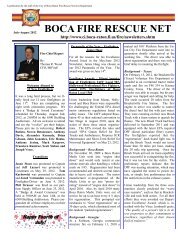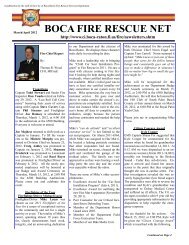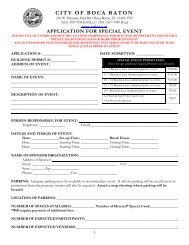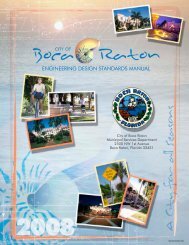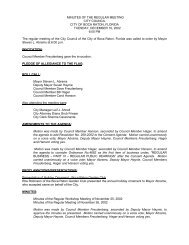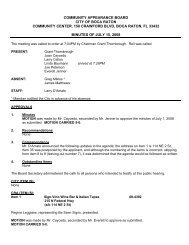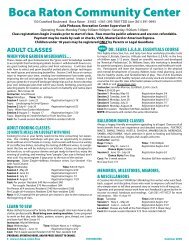BOCA FIRE RESCUE NET - City of Boca Raton
BOCA FIRE RESCUE NET - City of Boca Raton
BOCA FIRE RESCUE NET - City of Boca Raton
You also want an ePaper? Increase the reach of your titles
YUMPU automatically turns print PDFs into web optimized ePapers that Google loves.
Page 5<br />
EMS<br />
By: Mike O’Neil<br />
Division Chief<br />
ALS Competition<br />
Our Advanced Life Support Competition<br />
Teams placed First in a competition<br />
in New York, and placed Second<br />
and Third at the Flagler County ALS<br />
Competition last month. The <strong>City</strong> <strong>of</strong><br />
<strong>Boca</strong> <strong>Raton</strong>’s web site (http://<br />
www.ci.boca-raton.fl.us/fire/pdf/<br />
CompetitionResults.pdf) lists competition<br />
results from 1981 to the present.<br />
The next competition is at Fire Rescue<br />
East this January.<br />
Medical Protocol Revision<br />
The EMS Division will be releasing<br />
new medical protocols in November.<br />
We are adding several new medications<br />
and the new American Heart Association<br />
recommendations have been added<br />
to the protocols. Along with the revision,<br />
we have completely revised the<br />
format <strong>of</strong> all EMS related forms, vehicle<br />
inventories, created reference guides<br />
and operating instructions for major<br />
equipment. All <strong>of</strong> these will be available<br />
on our network and on the laptop<br />
computers.<br />
Patient Follow Up Program<br />
<strong>Boca</strong> <strong>Raton</strong> Regional Hospital has been<br />
updating the EMS Division on our most<br />
critical patients that are transported to<br />
BRRH. Delray Medical Center is also<br />
providing data outcome for patients.<br />
This process is accomplished using a<br />
secure electronic file exchange. We<br />
have received requests from other agencies<br />
around the State who are interested<br />
about our methods. This program was<br />
implemented as part <strong>of</strong> our Quality Assurance<br />
Program.<br />
<strong>BOCA</strong> <strong>FIRE</strong> <strong>RESCUE</strong><br />
Training & Safety<br />
By: Joe Majhess<br />
Division Chief<br />
As we put Halloween behind us, we are<br />
all eagerly anticipating the holiday season<br />
over the next few months. Whether<br />
it be to share a meal, the exchange <strong>of</strong><br />
gifts or any other special occasion, coming<br />
together to celebrate with family and<br />
friends is a blessing we can all enjoy.<br />
In the last month, I attended training at<br />
the National Fire Academy in Emmitsburg,<br />
Maryland. Course discussion focused<br />
on how we, as a Fire Rescue service,<br />
can reduce risks in our community.<br />
In conducting research to prepare for<br />
attending this training, I discovered<br />
some interesting facts and statistics that<br />
are worth sharing.<br />
In the United States, the leading cause<br />
<strong>of</strong> death for persons ages 1 – 44 is unintentional<br />
injuries. Injuries stemming<br />
from Motor Vehicle Crashes is the number<br />
one cause <strong>of</strong> death in approximately<br />
98% <strong>of</strong> these cases. In fact, the industry<br />
has gone as far as reclassifying these<br />
events as “crashes” rather than<br />
“accidents.” Why? Because in a majority<br />
<strong>of</strong> cases, these incidents are not accidents<br />
at all, they are “PREVENTABLE”<br />
incidents. Other leading causes include<br />
drowning, fire/burns, suffocation, poisoning<br />
and falls. In these incidents as<br />
well, a majority <strong>of</strong> cases are preventable.<br />
I cannot tell you how many times in my<br />
20 years <strong>of</strong> responding to people’s<br />
tragedies that I have heard the victim’s<br />
family members express, through the<br />
hysteria, tears and sadness, a desire to<br />
have done things differently in the<br />
events leading up to their devastating<br />
loss. Folks, something as simple as putting<br />
a seatbelt or bike helmet on can<br />
mean the difference between life and<br />
death. Not allowing ourselves to be<br />
distracted when performing tasks such<br />
as driving or supervising children<br />
greatly improves our chances <strong>of</strong> avoiding<br />
“preventable” incidents.<br />
Sadly, in most cases, humans must experience<br />
a “significant emotional event”<br />
in order to change a negative behavior<br />
or habit. I share this information with<br />
you to raise your awareness <strong>of</strong> just<br />
some <strong>of</strong> the many hazards present in<br />
your everyday travels and educate you<br />
on the risks they pose to your health<br />
and safety and that <strong>of</strong> your family<br />
members. Will this be sufficient to<br />
motivate you to make the positive<br />
changes necessary to reduce your exposure<br />
to these hazards and risks or will<br />
you, like many, wait to experience your<br />
own personal “significant emotional<br />
event?”<br />
With these thoughts in mind, I ask you<br />
to observe your actions in the course <strong>of</strong><br />
just one day and count the number <strong>of</strong><br />
times you have the power to make a<br />
choice that could decrease the exposure<br />
<strong>of</strong> hazards and risks to you and/or those<br />
around you (family, friends, coworkers,<br />
the public). I believe the results will<br />
surprise you.<br />
In closing, I learned a lot in my recent<br />
training about reducing risk in our community.<br />
While the Fire Rescue Service<br />
can play a major role in educating the<br />
public on hazard awareness and ways to<br />
reduce their risks, only the public’s<br />
willingness to act on the information<br />
provided can lead to a reduction in the<br />
number <strong>of</strong> deaths due to unintentional<br />
injuries. Together, we can all play a<br />
part in reducing the risks in our community.<br />
We can all make choices that<br />
not only increase our safety, but also<br />
foster good habits in the youth that look<br />
to us for examples.<br />
I would like to take this opportunity to<br />
recognize and thank Ms. Cindy Cevallos<br />
for all her assistance with the research<br />
conducted on emergency reporting<br />
data in the <strong>City</strong> <strong>of</strong> <strong>Boca</strong> <strong>Raton</strong> for<br />
this project.



